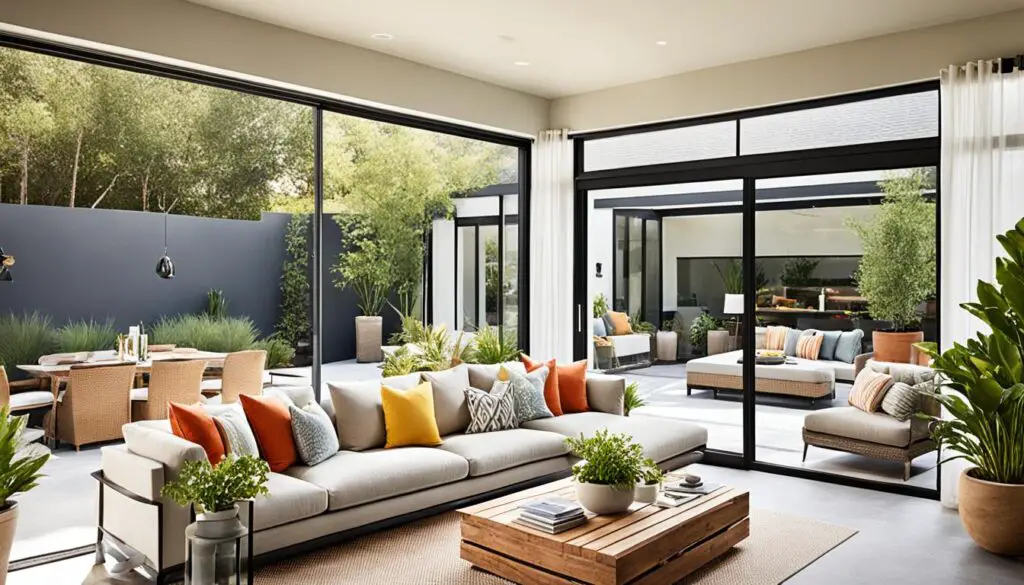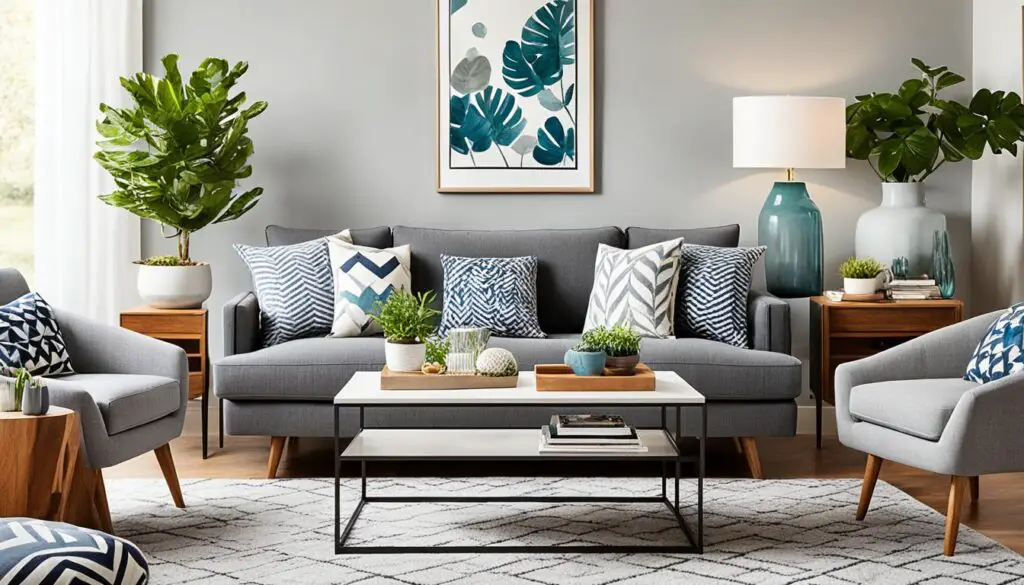Creating a calming atmosphere in your home is easier than you think. Embracing simplicity in your living space can make you feel more comfortable and relaxed.
A minimalist living room is all about the basics. It needs comfy seating, good lighting, and window treatments for privacy and to control the temperature. These elements help create a peaceful space where you can unwind.
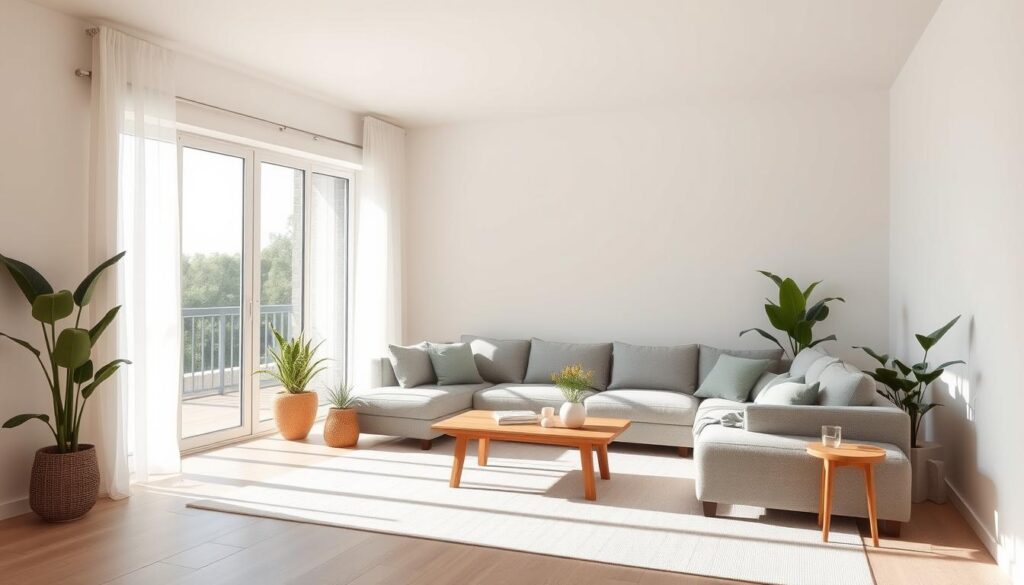
With minimalist living room inspirations, you can turn your space into a peaceful haven. It’s about finding the perfect balance between looks and usefulness. This way, your living area will be both stunning and practical.
Understanding Minimalism in Interior Design
At its core, minimalism is about making space for what truly matters. It focuses on simplicity, clean lines, and a few colors. This creates a calm and tidy environment.
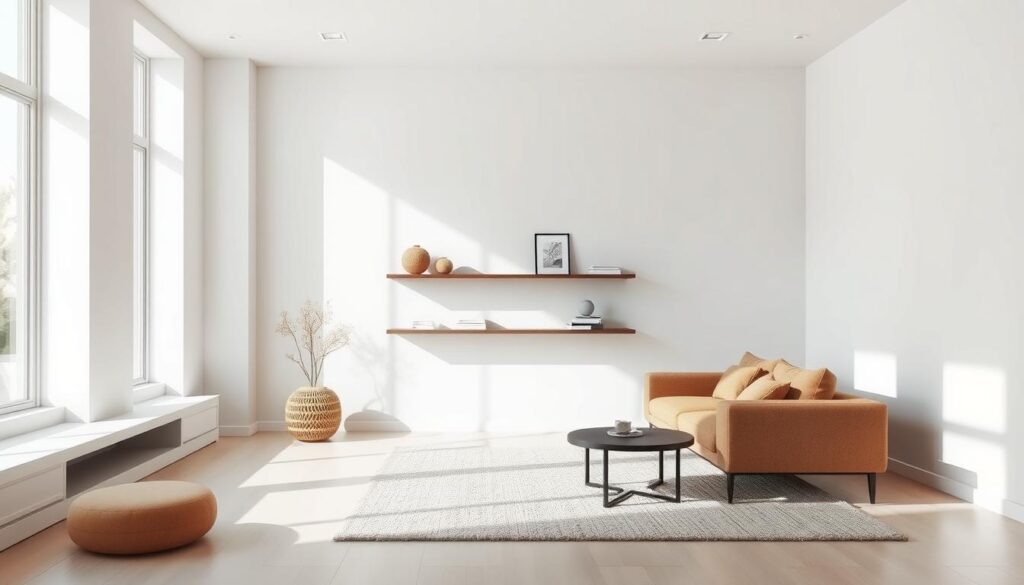
Minimalism in interior design is more than just getting rid of clutter. It’s a way of living that values sustainability and lessens waste. By using modern minimalist decor ideas, homeowners can make a living room that looks great and is easy to keep up.
What is Minimalism?
Minimalism is a design philosophy that sticks to the basics. It gets rid of things we don’t need to create a simple space. It uses neutral colors, natural light, and simple furniture and decor.
A simple living room design has open spaces, few decorations, and focuses on function. This design makes a space look good and feel peaceful and organized.
Benefits of a Minimalist Living Room
One big plus of a minimalist living room is less stress. Clutter can make us feel overwhelmed and anxious. But a minimalist space helps us relax and feel calm.
- A minimalist living room is easy to clean and keep up.
- It promotes sustainability by needing less stuff.
- It makes each piece of furniture or decor more special.
By using modern minimalist decor ideas, people can make a space that is both beautiful and useful. It follows the principles of simple living room design.
Key Elements of Minimalist Living Rooms
Adopting Scandinavian minimalism turns your living room into a peaceful retreat. It focuses on simplicity, function, and natural elements.
To make a calm space, knowing the main parts of a minimalist living room is key.
Color Palettes
Neutral colors like white, beige, and grey are typical in minimalist rooms. They bring calm and let your furniture and decor stand out.
- White: Provides a clean and airy feel
- Beige: Adds warmth without cluttering the space
- Grey: Offers a balanced and serene atmosphere
Essential Furniture Pieces
Minimalist rooms have comfy seating, coffee tables, and bookshelves. Choose items that are both useful and look good.
| Furniture Piece | Characteristics |
|---|---|
| Comfortable Seating | Sleek designs, minimal patterns, neutral colors |
| Coffee Tables | Simple shapes, clean lines, minimal ornamentation |
| Bookshelves | Minimalist frames, organized book arrangement |
The Role of Light
Natural light is vital in minimalist design. It makes the space feel open and calm. Try to keep windows clear of obstructions.
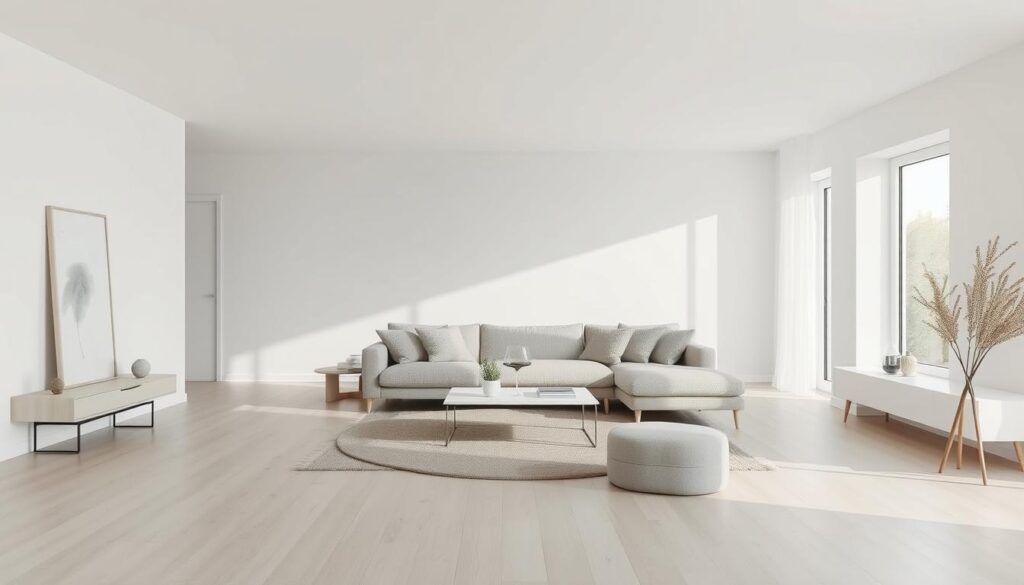
In summary, minimalist living rooms are peaceful and welcoming. They use neutral colors, essential furniture, and lots of natural light. This way, you can create a clean, Scandinavian-inspired home.
Choosing a Minimalist Color Palette
Minimalist living rooms use the right colors to stay simple and elegant. A good color scheme makes the room look better and feel calm. This is what makes minimalist spaces special.
Neutral colors are at the heart of a minimalist color palette. They make the room look clean and simple. This lets you add minimalist furniture without clutter.
Neutral Tones
Neutral colors like whites, creams, and grays are key in minimalist design. They are calming and help the room feel connected. They let your eyes move easily without being stopped by bright colors.
Here’s a table showing how different neutral colors can change a minimalist living room:
| Neutral Tone | Description | Effect on Room |
|---|---|---|
| Soft White | A clean and crisp white | Creates a sense of brightness and airiness |
| Warm Beige | A comforting, earthy tone | Adds warmth without being overpowering |
| Light Gray | A balanced, neutral gray | Provides a sophisticated and modern feel |
Pops of Color
Neutral colors are the base of a minimalist color palette. But, adding pops of color can make the room more interesting. These colors should be used carefully to keep the room simple.
Choose muted or pastel colors for their soft, yet engaging look. A single bold piece, like art or a vase, can add color without too much.
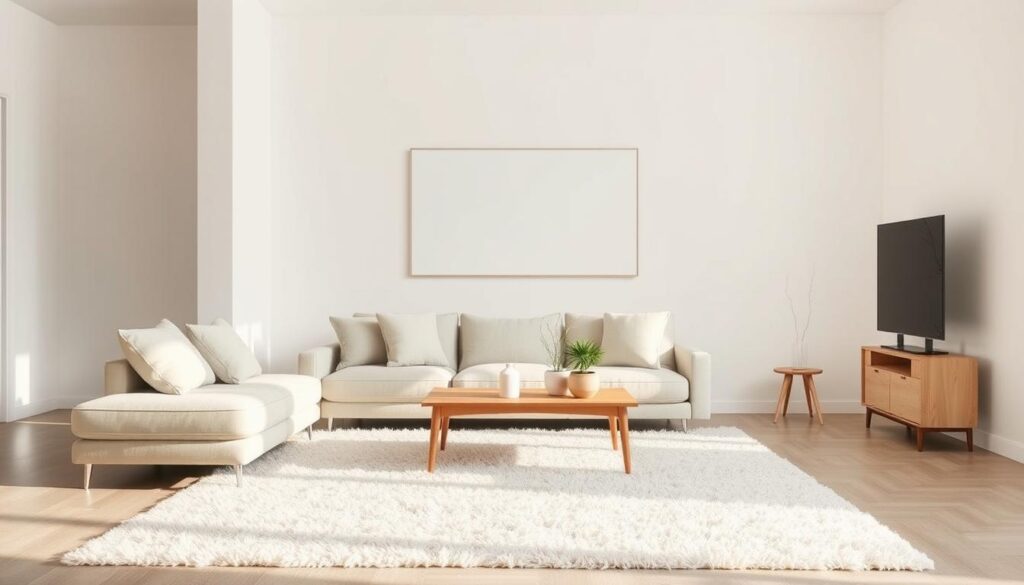
By mixing neutral colors with careful pops of color, you can make a minimalist living room that’s both calm and beautiful. This balance keeps the minimalist look while letting you express yourself.
Furniture Selection for Minimalist Living Rooms
Choosing the right furniture is key for a minimalist living room. It should be both useful and look good. Each piece should have a purpose and fit the minimalist style.
Functional vs. Aesthetic
In minimalist design, furniture needs to look good and work well. Functional furniture does its job, and aesthetic appeal makes it fit the room’s look. For example, a sleek sofa is comfy and keeps the room’s clean lines.
Multi-purpose Furniture
Multi-purpose furniture is vital in minimalist living rooms. It cuts down on clutter and makes the room more useful. Items like storage ottomans and tables with storage are great. They add storage or serve more than one purpose without making the room look messy.
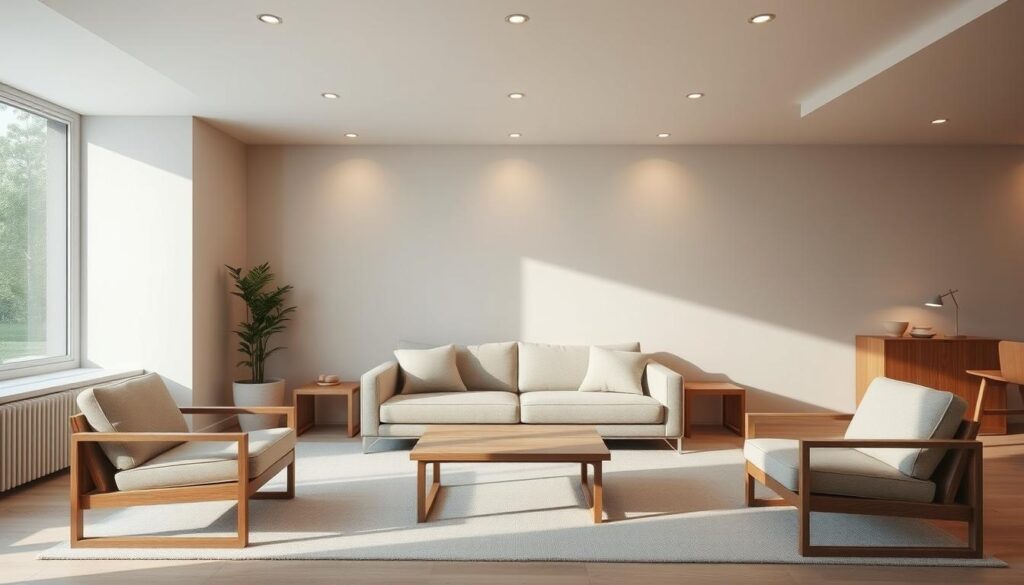
When picking multi-purpose furniture, think about its size and how it fits with the room. Also, choose items that match the room’s colors and style. This keeps the look consistent.
By picking furniture that is functional, looks good, and does more than one thing, you can make a minimalist living room. It will be both beautiful and practical, following the minimalist design principles.
Creating Space with Layout
In minimalist design, the layout is key. It balances openness and coziness. A well-designed layout makes a room feel spacious and inviting.
Open Floor Plans
Open floor plans are a hallmark of modern minimalist design. They remove unnecessary walls, creating a sense of spaciousness and flow. This design makes the living room feel larger and improves interaction between areas.
Benefits of Open Floor Plans include better natural light and improved social interaction. But, it’s important to balance openness with defined areas to avoid a disjointed feel.
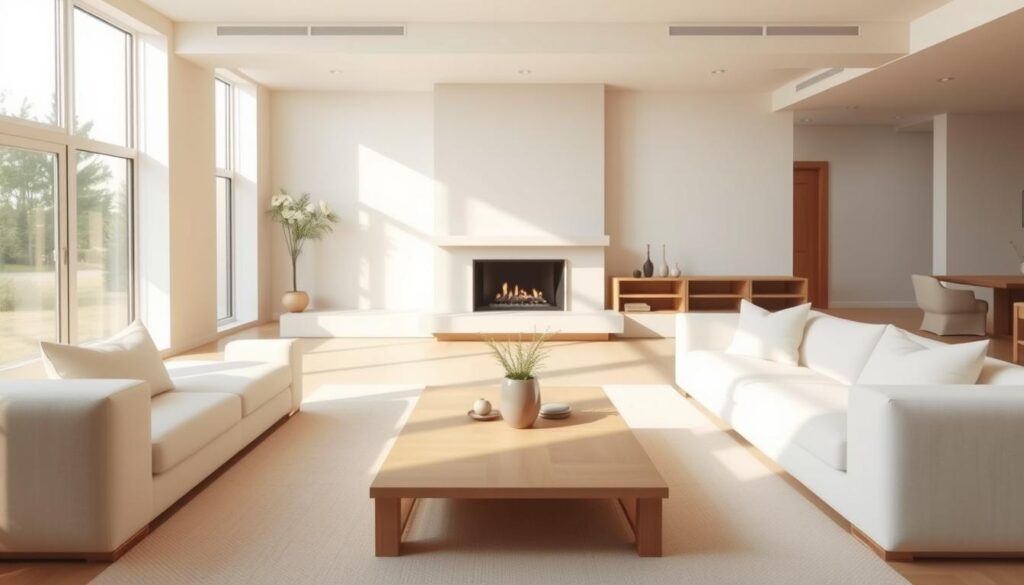
Zoning a Minimalist Room
Zoning is a technique to define areas in an open-plan space without walls. It uses furniture, rugs, and lighting strategically. This way, homeowners can keep their living room open while defining different areas.
Effective zoning needs careful furniture and placement choices. For example, a minimalist sofa can mark the seating area. A rug can separate the living and dining spaces.
To create a harmonious and functional minimalist living room, balance is key. By planning the layout and using zoning, homeowners can make a space that feels both spacious and cozy.
Accessorizing the Minimalist Living Room
The art of accessorizing a minimalist living space is about finding a balance. It’s about adding decor that enhances the room’s feel without making it cluttered.
Thoughtful Decor Choices
Choosing the right decor is key in a minimalist living room. A few statement pieces that reflect your style can make the space unique. For example, a special artwork or a unique vase can catch the eye and start conversations.
Remember the principle of restraint when picking decor. Too many items can make the space feel cluttered. Instead, pick a few items that match the room’s simple design.
Importance of Negative Space
Negative space is vital in minimalist design. It brings calm and balance, letting the eye rest. In a clean space, negative space is not just empty space. It’s a design choice that makes the space look better.
To use negative space well, think about where you place furniture and decor. Make sure there’s enough room between items for a sense of openness. This makes the space look better and feel more welcoming.
Plants and Natural Elements
Adding plants and natural elements can warm up a minimalist living room. Plants bring nature inside, improving air quality and creating calm. Choose easy-to-care-for plants like succulents or air plants that fit the minimalist style.
| Natural Element | Benefits | Tips for Incorporation |
|---|---|---|
| Plants | Purify air, add visual interest | Select low-maintenance varieties |
| Wood Accents | Add warmth, texture | Use in furniture or decorative items |
| Stone or Rock | Create a natural focal point | Incorporate into decor or vases |
By carefully adding these elements, you can make a minimalist living room that’s both beautiful and useful. The goal is to keep it simple yet personal, so your space feels welcoming and uncluttered.

Lighting in Minimalist Design
Minimalist living rooms use smart lighting to keep their look clean and simple. Lighting is more than just a need; it’s a key part of the room’s feel.
Using natural light is a big part of minimalist design. It makes rooms feel bigger and brighter, cutting down on the need for artificial light. To get the most natural light, keep windows open and use light curtains or blinds.
Natural Light Usage
Getting the most out of natural light is key in minimalist design. It adds warmth and coziness without needing extra lights. Here are some tips to use natural light better:
- Place mirrors by windows to bounce light deeper into the room.
- Choose light, airy window treatments like sheer curtains.
- Don’t block windows with too many things to let in more sunlight.
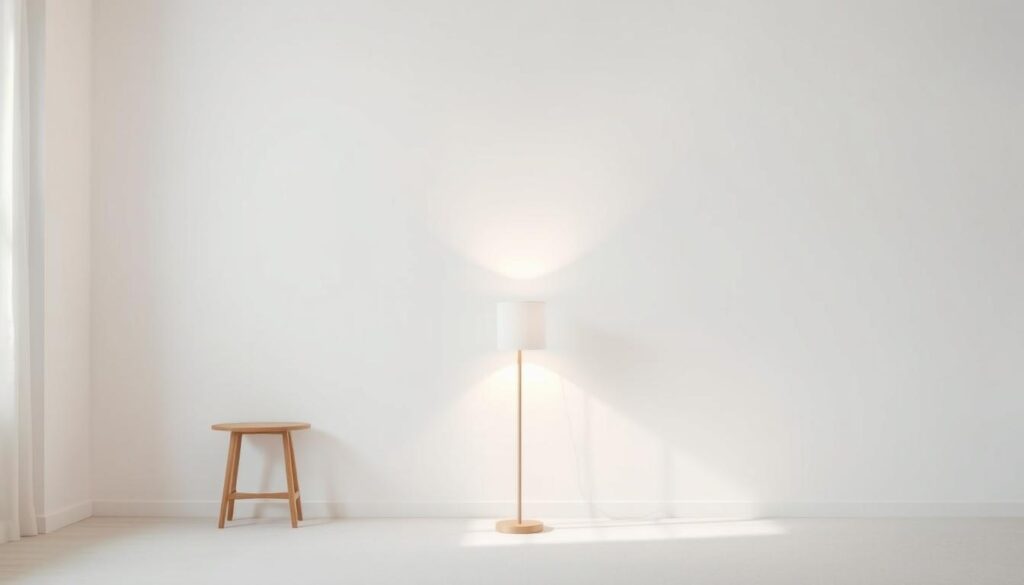
Statement Lighting Fixtures
Statement lighting fixtures are also important in minimalist living rooms. They add personality and style. Look for fixtures that are sleek yet stand out.
Good choices include unique pendant lights, modern floor lamps, and geometric chandeliers. The goal is to pick something that fits the minimalist look without taking over the space.
By mixing natural light with special lighting, you can make a minimalist living room that’s both stylish and practical.
Minimalist Living Room Inspirations from Real Homes
Looking at real-life minimalist living rooms can inspire your own space. Seeing how others use minimalist design helps you create a calm and useful living area.
Urban Apartment Inspirations
Urban apartments face unique challenges for minimalist design because of their small size. But, this can spark creativity. Using Scandinavian minimalism can make a space look clean and simple. Scandinavian minimalism is known for:
- Light color palettes
- Simple, functional furniture
- An emphasis on natural light
Design experts say the secret to a great urban minimalist living room is simplicity and function. Choose furniture that does more than one thing and keep things tidy.

Cozy Suburban Living Room Ideas
Suburban living rooms have more room, allowing for a different minimalist style. Cozy suburban living rooms can include:
- Warm, neutral color schemes
- Comfortable, minimalist furniture
- Textiles and natural elements to add warmth
Using negative space is a key part of suburban minimalist design. It helps create a calm and welcoming space. By arranging furniture and decor thoughtfully, you can make a room feel both spacious and cozy.
“The best rooms have character and soul, and a minimalist approach can help you achieve just that.”
Tips for Achieving Your Minimalist Vision
To get a minimalist living room, you need to declutter and decorate wisely. A few simple steps can help you create a space that’s both clutter-free and reflects your style.
Effective Decluttering
Decluttering is key to a minimalist space. Begin by getting rid of things you don’t need. Sort your belongings into groups. This makes your room feel calm and clear.
Personalizing Your Space
Adding personal touches, like artwork or decorative items, can make your space unique. Pick a few items that show off your personality and style.
By decluttering and decorating thoughtfully, you can achieve a minimalist look that’s both beautiful and useful. This way, your living room will be peaceful and welcoming, embodying minimalist design principles.

